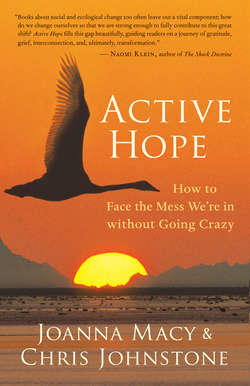Читать книгу Active Hope - Joanna Macy - Страница 18
На сайте Литреса книга снята с продажи.
THE FIRST STORY: BUSINESS AS USUAL
ОглавлениеOf the food you’ve eaten in the last twenty-four hours, how much is based on ingredients produced hundreds, or even thousands, of miles away? For most of us living in industrialized countries, the answer is lots of it. The average carrot, head of lettuce, or box of strawberries sold in supermarkets in Iowa, for example, is likely to have traveled more than eighteen hundred miles.3 And it’s not just our food: many of the things we use have traveled vast distances to reach us. Transportation costs are a major factor in making ours the most energy-costly era in history. Ari Fleischer might think of this as the American way of life. But it isn’t just American. Increasingly, for those living in affluent parts of our world, it is becoming the modern way, the accepted way, the one we think of as normal.
This modern life we’re describing holds many attractions. It’s common for people to take vacations in faraway places and to have their own cars, computers, televisions, and fridges. Just a few generations ago, such comforts, if attainable at all, would have been seen as the preserve of the super-rich. Nowadays advertisements give the impression that everyone should have these things, and progress is measured in terms of how much more we have than we used to or how much farther and faster we can go.
One way of thinking about our times is that we are enacting a wonderful success story. Economic and technological development has made many aspects of our lives easier. If we’re looking at how to move forward, the path this story suggests is “more of the same, please.” We’re calling this story Business as Usual.
This is the story told by most mainstream policy makers and corporate leaders. Their view is that economies can, and must, continue to grow. Even in the face of economic downturns and periods of recession, the dominant assumption is that it won’t be long before things pick up again. Expressing his trust in the path of economic growth, in November 2010 President Obama said, “The single most important thing we can do to reduce our debt and deficits is to grow.”4
For a market economy to grow, it needs to increase sales. That means encouraging us to buy, and consume, more than we already do. Advertising plays a key role in stimulating consumption, and increasingly children are targeted as a way of boosting each household’s appetite for goods. Estimates suggest that the average American child watches between twenty-five thousand and forty thousand television commercials a year. In the United Kingdom, it is about ten thousand.5 As we grow up, we learn by watching others. Our views about what’s normal and necessary are shaped by what we see.
When you’re living in the middle of this story, it’s easy to think of it as just the way things are. Young people may be told there is no alternative but to find their place in this scheme of things. Getting ahead is presented as the main plot, supported by the subplots of finding a partner, fending for your family, looking good, and buying stuff. In this view of life, the problems of the world are seen as far away and irrelevant to the dramas of our personal lives.
Transmitted by global media, this story of modern living is catching on around the world and arousing an increasing appetite for consumption. Before 1970 just four items were regarded as essential purchases in China — a bicycle, a sewing machine, a wristwatch, and a radio. By the 1980s a growing consumer class had expanded this list to include a fridge, a color TV, a washing machine, and a tape recorder. A decade later, it had become normal for more and more people in China to have a car, a computer, a mobile phone, and air conditioning.6 And it’s a list that’s still growing, as Joe Hatfield, CEO of Walmart Asia, explains:
We started out with four feet of skin care; today it’s twenty feet. Today we don’t have deodorants, but someday down the road we will have deodorants in China. Five years ago perfumes were not a big business here. But if you look today it’s the emerging market…there’s a lot fewer bicycles, so that takes away from the exercise side of it, so people are getting larger, so what’s that tell you? Sales of exercise equipment’s getting good, exercise wear, jogging outfits, and at some point, we’ll have Slimfast and all those type of products.7
Some view this as progress.
Box 1.1. Some Core Assumptions of Business as Usual
• Economic growth is essential for prosperity.
• Nature is a commodity to be used for human purposes.
• Promoting consumption is good for the economy.
• The central plot is about getting ahead.
• The problems of other peoples, nations, and species are not our concern.
Why shouldn’t people in other parts of the world develop the lifestyle thought of as normal in the West? And why shouldn’t we continue with the Business as Usual of economic growth, with people buying more things and using so much energy (see Box 1.1)? To answer those questions, we need to look at the shadow side of modern living and also at where this is taking us. That leads us to our next story.
